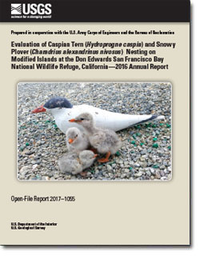Evaluation of Caspian tern (Hydroprogne caspia) and snowy plover (Charadrius alexandrinus nivosus) nesting on modified islands at the Don Edwards San Francisco Bay National Wildlife Refuge, California—2016 Annual Report
Links
- Document: Report (3.8 MB pdf)
- Download citation as: RIS | Dublin Core
Executive Summary
In order to address the 2008/10 and Supplemental 2014 NOAA Fisheries Biological Opinion for operation of the Federal Columbia River Power System, the U.S. Army Corps of Engineers (USACE) and the Bureau of Reclamation (Reclamation) developed and have begun implementation of Caspian tern (Hydroprogne caspia) management plans. This implementation includes redistribution of the Caspian terns in the Columbia River estuary and the mid-Columbia River region to reduce predation on salmonids listed under the Endangered Species Act. Key elements of the plans include (1) reducing nesting habitat for Caspian terns in the Columbia River estuary and the mid-Columbia River region, and (2) creating or modifying nesting habitat at alternative sites within the Caspian tern breeding range. USACE and Reclamation developed Caspian tern nesting habitat at the U.S. Fish and Wildlife Service Don Edwards San Francisco Bay National Wildlife Refuge (DENWR), California, prior to the 2015 nesting season. Furthermore, to reduce or eliminate potential conflicts between nesting Caspian terns and threatened western snowy plovers (Charadrius alexandrinus nivosus), nesting habitat for snowy plovers also was developed. Seven recently constructed islands within two managed ponds (Ponds A16 and SF2) of DENWR were modified to provide habitat attractive to nesting Caspian terns (5 islands) and snowy plovers (2 islands). These 7 islands were a subset of 46 islands recently constructed in Ponds A16 and SF2 to provide waterbird nesting habitat as part of the South Bay Salt Pond (SBSP) Restoration Project.
We used social attraction methods (decoys and electronic call systems) to attract Caspian terns and snowy plovers to these seven modified islands, and conducted surveys between March and September of 2015 and 2016 to evaluate nest numbers, nest density, and productivity. Results from the 2015 nesting season, the first year of the study, indicated that island modifications and social attraction measures were successful in establishing Caspian tern breeding colonies at Ponds A16 and SF2 of DENWR. The success of 2015 continued in 2016, the second year of the study. In 2016, Caspian terns nested on two of the five islands modified for Caspian terns (one island in Pond A16 and one island in Pond SF2). Caspian terns initiated at least 317 nests, fledged at least 158 chicks, and had a breeding success rate of 0.50 fledged chicks per breeding pair. This represents a 42 percent increase in nests initiated, a 9 percent decrease in the number of fledged chicks, and a 36 percent decrease in the number of chicks fledged per breeding pair in 2016 compared to 2015. Although overall productivity decreased from 2015, these results indicate that the Caspian tern breeding population on modified islands of the DENWR is increasing relative to 2015, the first year of the effort, and relative to years prior to 2015 when no breeding colonies of Caspian terns existed in Ponds A16 or SF2. These results indicate the effectiveness of social attraction measures in helping to establish tern nesting colonies in San Francisco Bay. Conversely, for the second year in a row, snowy plovers did not attempt to nest on any island in Ponds A16 and SF2. Social attraction measures similar to those used in this study, but targeting other colonial species such as Forster’s terns (Sterna forsteri) and American avocets (Recurvirostra americana), may help to establish waterbird breeding colonies at wetlands enhanced as part of the SBSP Restoration Project.
Suggested Citation
Hartman, C.A., Ackerman, J.T., Herzog, M.P., Strong, Cheryl, Trachtenbarg, David, and Shore, C.A., 2017, Evaluation of Caspian tern (Hydroprogne caspia) and snowy plover (Charadrius alexandrinus nivosus) nesting on modified islands at the Don Edwards San Francisco Bay National Wildlife Refuge, California—2016 Annual Report: U.S. Geological Survey Open-File Report 2017-1055, 37 p., https://doi.org/10.3133/ofr20171055.
ISSN: 2331-1258 (online)
Study Area
Table of Contents
- Executive Summary
- Introduction
- Methods
- Results and Discussion
- Conclusions and Management Implications
- Acknowledgments
- References Cited
| Publication type | Report |
|---|---|
| Publication Subtype | USGS Numbered Series |
| Title | Evaluation of Caspian tern (Hydroprogne caspia) and snowy plover (Charadrius alexandrinus nivosus) nesting on modified islands at the Don Edwards San Francisco Bay National Wildlife Refuge, California—2016 Annual Report |
| Series title | Open-File Report |
| Series number | 2017-1055 |
| DOI | 10.3133/ofr20171055 |
| Publication Date | May 08, 2017 |
| Year Published | 2017 |
| Language | English |
| Publisher | U.S. Geological Survey |
| Publisher location | Reston, VA |
| Contributing office(s) | Western Ecological Research Center |
| Description | vi, 37 p. |
| Country | United States |
| State | California |
| Other Geospatial | Don Edwards San Francisco Bay National Wildlife Refuge |
| Online Only (Y/N) | Y |


